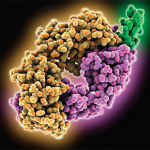Rituximab as Maintenance Therapy
The 80 patients on rituximab maintenance therapy had a median treatment duration of 24 months (range: 11–99 months), a median rituximab dose of 6 gm and a median follow up of 38 months. Table 1 lists disease and treatment characteristics after the first rituximab administration and after six months of rituximab maintenance therapy.
| Table 1 | ||
|
After First Rituximab Administration |
After 6 months on Rituximab Maintenance Therapy |
|
| Percentage of patients on prednisolone or immunosuppressive drugs |
|
|
| Mean ECLAM score |
3.5 |
1.86* |
| Treatment response |
|
30 (38%) had complete response, increasing to 48% at 24 months |
| *Significant decrease from 3.5 (P<0.0001) | ||
In the subgroup of 80 patients treated with rituximab maintenance therapy, 52 patients (65%) experienced 85 relapses at a median of 11.5 months. The most frequent sites of disease flare were in the joints (66% of patients) and skin (40% of patients). A total of 67 patients (84%) were in remission at the time of the last administration of rituximab.
Overall, 28 of 80 patients (35%) did not experience flare during the maintenance treatment and were considered sustained responders. In a multivariate analysis, the presence of active articular disease at the time of first rituximab administration was associated with the risk of flare during rituximab maintenance therapy after adjusting for disease severity.
“Apparently, a rituximab-based maintenance approach is not very effective in controlling musculoskeletal reactivations of the disease, and articular flares may occur during treatment,” says Dr. Alberici.
When looking at outcomes after the last rituximab infusion, data were available for 57 of the 80 patients (71%). At a median follow-up of 13 months from the last rituximab administration, 30 of these 57 patients (53%) experienced flares. The rate of flares involving major organs, particularly neurologic, pulmonary and hematologic flares, significantly increased after maintenance rituximab was withdrawn (67% vs. 38%; P=0.01). Additionally, no difference was observed in the median relapse-free survival after the last rituximab infusion between patients treated with a single course of rituximab and those treated with maintenance rituximab (16 and 17 months, respectively; P=0.72)
Dr. Alberici emphasizes the effects of maintenance rituximab were not sustained, with the relapse risk similar to that found in the patients treated with a single course of rituximab. He says this suggests a lack of impact on the long-term disease outcome or on the disease biology itself. He thinks this finding is particularly interesting considering that a rituximab-based maintenance regimen seems to prolong the post-treatment, relapse-free survival in anti-neutrophil cytoplasmic antibody (ANCA) associated vasculitis.

